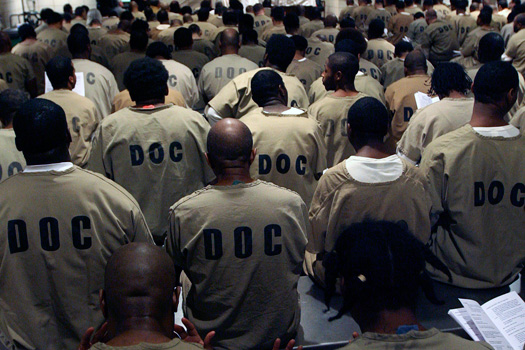Via: BoingBoing.net
Una parte molto consistente della popolazione carceraria americana è composta da afroamericani, che significa povera gente, emarginati, piccoli o medi criminali, assassini, ladri per necessità, tossici. Nulla di nuovo, essendo il sistema americano, sotto il profilo socio-culturale, un sistema di tipo punitivo, dove la colpa, quando non c’è, deve essere inventata. Infatti occorre continuamente riempire il serbatoio delle buone intenzioni e dei facili moralismi, soprattutto in un paese così grande ed egemone a livello internazionale.
Ta-Nehisi Coates’s longread in the Atlantic, “The Black Family in the Age of Mass Incarceration” is a stupendous piece of serious journalism, tracing the long history of system racism in America to the present day condition: America imprisons more people than any other country in the world; it imprisons more people than at any time in its history; and it imprisons black people, especially black men, at a rate that beggars belief.
Coates starts his story with Daniel Patrick Moynihan, a well-meaning campaigner and policy wonk who was nevertheless a racist and sexist jerk. In 1965, Moynihan was working for the Nixon’s Labor Department, where he prepared a hugely influential white-paper called “The Negro Family: The Case for National Action,” in which he mixed empathy for black families’ difficulties, stemming from historical and contemporary racism with calls for empowering black men at the expense of black women, putting black men in charge of the “matriarchal” families.
Whatever Moynihan intended, it backfired, and his report joined a long line of establishment doctrines espousing the intrinsic inferiority of black people and their culture and families.
Using Moynihan as a jumping-off point, Coates works through the treatment of black families under slavery and then emancipation, showing how the story of black criminality and the practice of black incarceration cast a long shadow over black lives across time and space, and became a self-fulfilling prophecy. The criminal records imposed on black people destroy black families, destroy ex-cons’ ability to find meaningful employment, deny them access to welfare benefits, and sends them back into the criminal justice system. This, in turn, becomes a justification for more incarceration.
Coates’s is one of the best thinkers in contemporary America, and here he is in full voice.
[…] By the end of her term, Richards had presided over “one of the biggest public works projects in Texas history,” according to Robert Perkinson’s Texas Tough: The Rise of America’s Prison Empire. In New York, another liberal governor, Mario Cuomo, found himself facing an exploding prison population. After voters rejected funding for more prisons, Cuomo pulled the money from the Urban Development Corporation, an agency that was supposed to build public housing for the poor. It did—in prison. Under the avowedly liberal Cuomo, New York added more prison beds than under all his predecessors combined.
This was penal welfarism at its finest. Deindustrialization had presented an employment problem for America’s poor and working class of all races. Prison presented a solution: jobs for whites, and warehousing for blacks. Mass incarceration “widened the income gap between white and black Americans,” writes Heather Ann Thompson, a historian at the University of Michigan, “because the infrastructure of the carceral state was located disproportionately in all-white rural communities.” Some 600,000 inmates are released from America’s prisons each year, more than the entire population of America’s prisons in 1970—enough people, according to Pager, to “fill every one of the fast-food job openings created annually nearly five times over.”
Dark predictions of rising crime did not bear out. Like the bestial blacks of the 19th century, super-predators proved to be the stuff of myth. This realization cannot be regarded strictly as a matter of hindsight. As the historian Naomi Murakawa has shown in her book, The First Civil Right: How Liberals Built Prison America, many Democrats knew exactly what they were doing—playing on fear for political gain—and did it anyway. Voting on the Anti–Drug Abuse Act of 1986, Nick Rahall II, a congressman from West Virginia, admitted that he had reservations about mandatory minimums but asked, “How can you get caught voting against them?” Congresswoman Patricia Schroeder of Colorado accused her colleagues of using the 1986 bill to score points before an election. In the end, she voted for it. “Right now, you could put an amendment through to hang, draw, and quarter,” said Claude Pepper, a historically liberal congressman from Florida, referring to the same law. Pepper also voted for it.
The Black Family in the Age of Mass Incarceration [Ta-Nehisi Coates/The Atlantic]
E’ inutile sottolineare, forse, poiché lo avrete già letto in inglese, le ripercussioni che questa condizione ha sulle famiglie afroamericane, sotto il profilo della continuità storica della condizione stessa. Una condizione che è, al tempo stesso causa ed effetto del sistema carcerario statunitense, fondato sulla segregazione sociale, prima ancora che razziale. Un contesto dove le differenze di classe, le differenze sociali, sono il detonatore della instabilità della società americana. Inoltre, sarà molto difficile per la comunità afroamericana, in queste condizioni, sviluppare la forza necessaria ad uscire da una certa marginalità sociale endemica, poiché la carcerazione, in quanto dispositivo normativo assoluto, rimarrà sempre il limite sistemico alla libertà di azione, ma anche di espressione, per l’insieme delle classi subalterne.


Be the first to comment on "Un saggio sull’incarcerazione di massa in America a spese degli afroamericani."